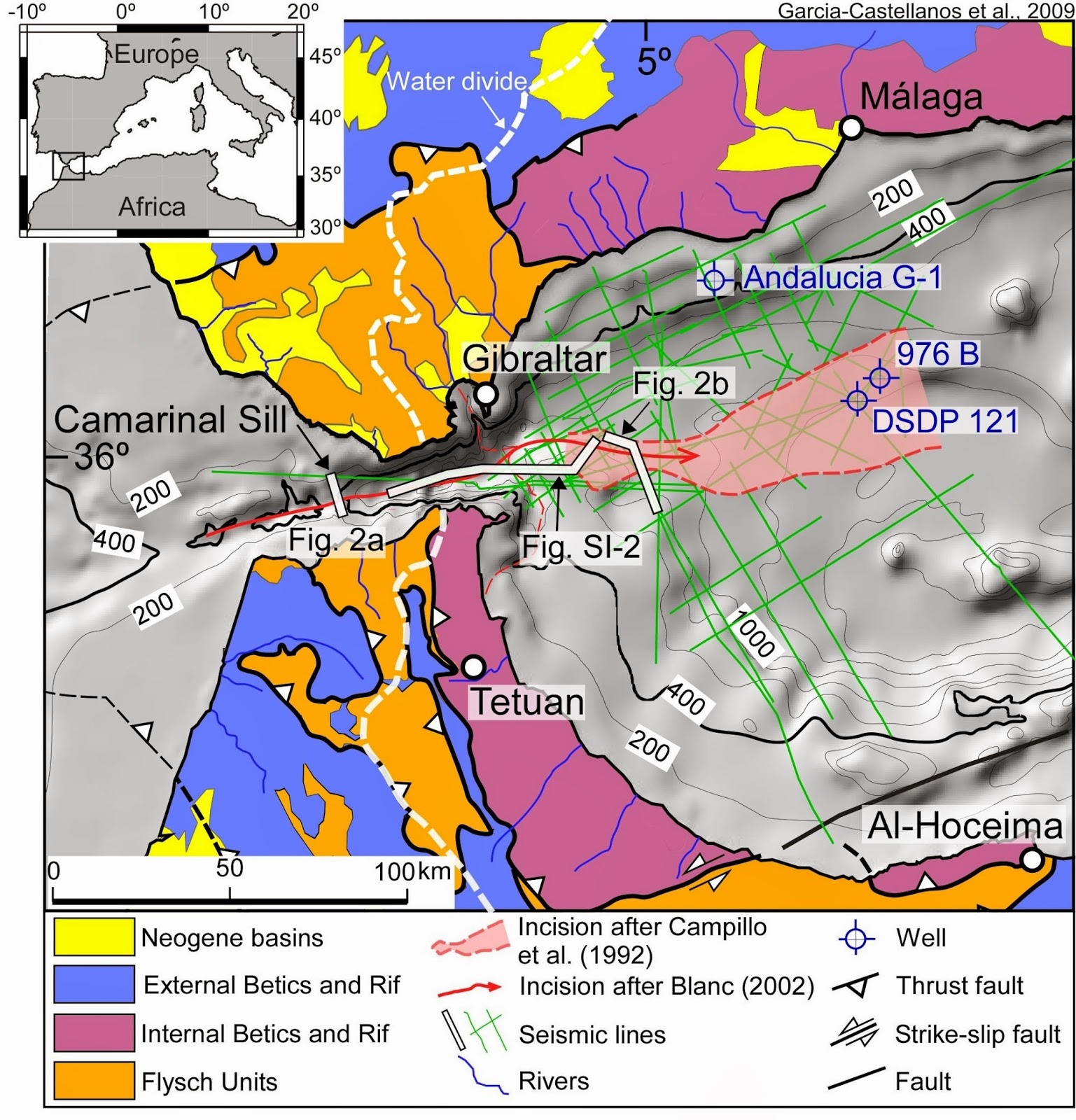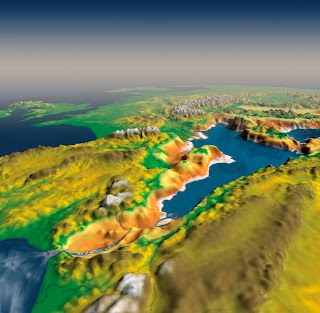 |
Fig. 1. Airy isostatic model: every column of rock above the
compensation level should have the same weight.
High topography is compensated by a mass deficit at
the base of the crust (crustal root) |
The term 'Dynamic Topography' is one of the top trending topics in Solid Earth science. It has now prevailed for more than 2 decades, but still the concept involves significant confusion. Dynamic Topography refers to a part of the elevation of the Earth surface that cannot be accounted by the classical crustal isostatic models (Pratt or Airy). But is the term referring to all mantle-sourced loads? Or only to those forces created by the dynamic flow of the mantle? Let's see first where the current confusion exactly comes from.
The term was actually
coined by oceanographers to refer to the deviations of the surface of the ocean relative to the Geoid (eg., Bruce, 1968; Wyrtki, 1975). In principle, the geoid should perfectly fit the surface of the ocean, since it is an equipotential surface of the gravity field, but the flow of water adds a secondary shift of the surface, normally less than a meter. This deviation from the surface predicted for a 'static' ocean (ie., the geoid) can be detected in satellite altimetry data because the signal noise introduced by tides, waves, and wind can be removed by time-filtering. The remaining deviation from the geoid is referred to by oceanographers as 'dynamic topography' and is known to be related to the water currents in the ocean.
 |
Fig. 2. Mean ocean dynamic topography from http://grace.jpl.nasa.gov, updated from Tapley et al., 2003).
It measures the long-term-averaged strength of ocean currents, the 'steady-state'
circulation.
|
In the 80s the term was adopted by solid-earth scientists (Hager et al., 1985,
Nature). The authors did not follow the original oceanographic meaning, but instead they included 'static' forces originated within the lithosphere (such as the weight of sinking plates, or
slab pull) as well as forces caused by flow in the mantle.
 |
| Mantle convection model: Mantle temperature (color shading) and flow (arrows). Lines indicate the calculated dynamic topography (blue line) and the horizontal component of plate motion (red, positive means eastward). From Liu et al., 2008, Science |
This made sense at the time because there was a big questionmark (still poorly answered today) about the origin of
hidden loads, the enigmatic forces needed to explain the depth of sediment accumulations next to mountain belts (see
Allen's book Foreland basins, or
this article pdf). Sedimentary basins next to orogens in compressional plate boundaries are formed by the isostatic sinking (subsidence) of the lithosphere due to the weight of the growing orogen. These settings became very attractive in solid-earth science not only for prospection purposes, but also because they provide an opportunity to understand how tectonic processes interact with the erosion and transport of sediment in the surface, since the sedimentary layers in such foreland basins record the tectonic evolution of the mountain belt. After many of these foreland basins were modeled, it became clear that the isostatic load of the orogen was generally insufficient to explain the amount of subsidence of the basin. But linking all the hidden load to dynamic effects is misleading, because of the presence of static forces such as the weight of a sinking plate attached to the surface (a lithospheric slab), well known since plate tectonics became mainstream. Another key to understanding the confusion is that before the widespread development of
seismic tomography, everything occurring below crustal levels was far more conjectural than today. As a result, part of the Solid-Earth community used the term
dynamic topography to refer to all deep-seated forces (originated below the crust) that had an effect on topography, including for instance changes in the thickness of the lithospheric mantle, or a lithospheric slab.
 |
Fig. 3. Two static forces in balance
(weight of the books and the
counteracting human force) |
 |
Dynamic forces are added to the
static force to recover the balance
and avoid the books from falling. |
In physics, static vs. dynamic forces refer to whether the forces are in equilibrium (perfectly compensated) or not, and dynamic physical problems refer to motions involving acceleration. This is an additional source of confusion, since both the ocean flow and the Earth's mantle flow can be under steady-state flow and still inflict a constant deflection of the topographic surface, that we yet call 'dynamic'.
But sticking to the original oceanographic definition (as for example in
Braun 2010), the dynamic topography of the solid-earth should restrict to the change in elevation produced by dynamic forces related to mantle viscous flow (and flow can only occur beneath the boundary layer of the mantle, underneath the lithosphere). This definition seems robust because the lithosphere is defined based on its strength relative to the underlying asthenosphere, and hence flow-related stresses are expected to be negligible above the lithosphere-asthenosphere boundary (LAB). The fact that the flow is generated by density contrasts does not mean that the forces can be mistaken for static ones, because those density anomalies are out of the rigid body being deformed (the lithosphere).
We therefore can split the observed topography OT into:
OT = CIT + LMIT + MFDT
where CIT is the crustal isostatic topography; LMIT is the Lithospheric-mantle isostatic topography (including slabs attached to the Earth's crust, or the thinning of the lithosphere); and MFDT is the sublithospheric mantle-flow dynamic topography. Note that OT-CIT (easy to calculate using global databases of crustal thickness) is often called residual topography (RT).
Following this notation, the confusion can be described as emanating from some authors referring to LMIT+MFDT (which equals RT) as the dynamic topography, instead of MFDT alone. While this RT ranges in the order of +-1 km, there seems to be no consensus yet as to how large can MFDT be, with values ranging between that same value and a few hundred meters.
 |
Fig. 4. Global free-air gravity anomaly from GRACE. The low values (+-40 mGal) in comparison with the +- 300 mGal that are often attained in smaller regional scales shows that the crust is in overall isostatic equilibrium: the mass excess of topography at high-elevation areas is compensated by a mass deficit at the base of the crust. For this reason there is little correlation between anomaly and continents. The Hawaiian, Yellowstone, Iceland hotspots are represented by highs. Subduction zones show an asymmetrical pair of low & high anomaly. The Hudson Bay undergoes a glacial rebound in response to the deglaciation (+ info here).
|
Support for the smaller MFDT values comes from reasonings like this: Consider a Stokes sphere sinking or rising in a viscous fluid by virtue of its density contrast with the surrounding fluid (the viscous mantle for us). The vertical velocity of this sphere can be analytically solved and the expression obtained for the dynamic topography it produces depends on its radius
a, its density contrast relative to the fluid, the depth of the sphere, and the distance
R from the measuring point in the surface to the center of the sphere.
MFDT = ∆h[m] = 2*∆density * a^3 * D * (3D^2+3a^2-5*D^2*a^2/R^2) / (3*fluid_density*R^5)
 |
| Stokes' sphere sinking in a viscous fluid. The gravity anomaly and dynamic topography it generates are linearly proportional to each other. |
Because the free-air gravity anomaly produced by the same sphere (∆g) follows a similar equation, the relation between gravity and MFDT conveniently depends only on the of fluid density, to a first approach:
∆g[mGal] = 2πG * density[kg m-3] * MFDT[m]
This means that the +-40 mGal anomalies shown in the global map above should correspond to a dynamic topography smaller that 300-400 m (see P. Molnar's talk linked below).
Clearly, if we knew well the two isostatic contributions CIT+LMIT, then we would be able to attribute the rest to the flow in the mantle and learn about what happens at those depths. As Jean Braun puts it: "Mantle dynamics remain poorly constrained, but by linking mantle flow to surface topography (...) we can use the geological record to constrain the dynamics and viscosity of the mantle and the density structure that controls its flow".
The problem is that there are too many unknowns in the equation: computer models of 3D mantle flow that estimate dynamic topography rely on seismic tomographic imaging of the mantle that provide the distribution of seismic velocity anomaly but how to
translate this wave velocity into lateral inhomogeneities in density and viscosity is poorly known. So, fitting the computer models to the weak available observations of dynamic topography and plate tectonic reconstructions will provide only hints on a vague combination of the velocity-viscosity and the velocity-density relationships. So, this will remain as an
Earthling Challenge (a
Reto Terrícola) for quite some time.
For more information, I recommend
Peter Molnar's talk on youtube,
Philip Allen's blog post, or Braun's paper listed below. PS: Check also this recent
talk by Jean Braun on the interaction between erosion and dynamic topography.
References
- Allen, 2010, Surface impact of mantle processes, Nature Geoscience.
- Braun, Jean. "The many surface expressions of mantle dynamics." Nature Geoscience 3.12 (2010): 825-833.
- Bruce, J. G. "Comparison of near surface dynamic topography during the two monsoons in the western Indian Ocean." Deep Sea Research and Oceanographic Abstracts. Vol. 15. No. 6. Elsevier, 1968.
- Faccenna, C., Becker, T. W., Auer, L., Billi, A., Boschi, L., Brun, J.-P., Capitanio, F. A., Funiciello, F., Horvath, F., Jolivet, L., Piromallo, C., Royden, L., Rossetti, F., and Serpelloni, E.: Mantle dynamics in the Mediterranean. In press at Rev. Geophys., 2014. PDF
- Hager, Bradford H., et al. "Lower mantle heterogeneity, dynamic topography and the geoid." Nature 313.6003 (1985): 541-545.
- Tapley B.D., D.P. Chambers, S. Bettadpur and J.C. Ries, 2003: Large scale ocean circulation from the GRACE GGM01 Geoid. Geophys. Res. Letters 30 (22):doi:10.1029/2003GL018622
- Wyrtki, Klaus. "Fluctuations of the dynamic topography in the Pacific Ocean."Journal of Physical Oceanography 5.3 (1975): 450-459.
































